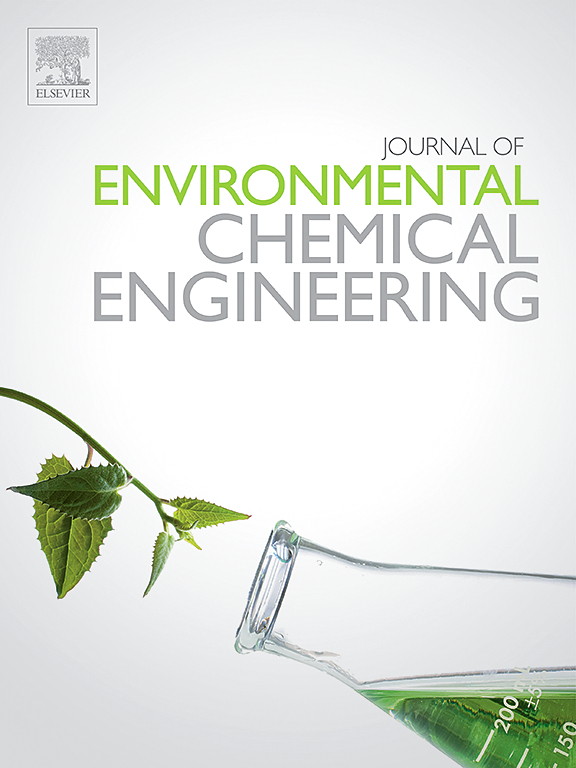Dual-sulfur defects decorated 1T-WS2/Cd0.5Zn0.5S heterojunctions for boosted photocatalytic hydrogen evolution
IF 7.4
2区 工程技术
Q1 ENGINEERING, CHEMICAL
引用次数: 0
Abstract
Defect engineering has emerged as a powerful strategy for enhancing photocatalytic performance. In this paper, a novel dual-defect 1T-WS2/Cd0.5Zn0.5S (WSv/CZSv) Schottky heterojunction was successfully fabricated via a combined solvothermal-hydrothermal approach. Electron paramagnetic resonance (EPR) and high-resolution TEM (HRTEM) confirmed the presence of dual sulfur vacancies. The optimized WSv/CZSv composite exhibits exceptional hydrogen evolution performance, achieving a remarkable rate of 3060.63 μmol·g−1·h−1, which are 9.83 and 2.54 times higher than that of pure CZS and CZSv, respectively. Notably, the catalyst maintained over 90 % of its initial activity after four consecutive photocatalytic cycles, demonstrating superior stability. Comprehensive characterization through electrochemical impedance spectroscopy (EIS), steady-state photoluminescence (PL), and transient photocurrent measurements revealed that the dual-defect system significantly enhances carrier separation efficiency. This improvement arises from three synergistic effects: electron-trapping capability of dual defect sites, elevated Schottky barrier, and superior electrical conductivity of the 1T-WS2. Furthermore, the metallic characteristics and sulfur vacancies in 1T-WS2 synergistically provide abundant active sites for photocatalytic hydrogen evolution on both basal planes and edges. Density functional theory (DFT) calculations indicate that the dual defects optimize charge distribution and achieve an ideal hydrogen adsorption free energy. The energy band alignment and charge transfer mechanism were systematically investigated using Mott-Schottky (M-S) analysis and ultraviolet photoelectron spectroscopy (UPS). This work explores the synergistic interactions between different types of sulfur defects and provides new insights into the coupling of defect engineering.
双硫缺陷修饰1T-WS2/Cd0.5Zn0.5S异质结促进光催化析氢
缺陷工程已成为提高光催化性能的有力策略。本文采用溶剂热-水热相结合的方法成功制备了新型双缺陷1T-WS2/Cd0.5Zn0.5S (WSv/CZSv) Schottky异质结。电子顺磁共振(EPR)和高分辨率透射电镜(HRTEM)证实了双硫空位的存在。优化后的WSv/CZSv复合材料具有优异的析氢性能,析氢速率达到3060.63 μmol·g−1·h−1,分别是纯CZS和纯CZSv的9.83和2.54倍。值得注意的是,在连续四个光催化循环后,催化剂保持了超过90% %的初始活性,表现出优异的稳定性。通过电化学阻抗谱(EIS)、稳态光致发光(PL)和瞬态光电流测量的综合表征表明,双缺陷体系显著提高了载流子分离效率。这种改进源于三个协同效应:双缺陷位的电子捕获能力、肖特基势垒的提高和1T-WS2优越的导电性。此外,1T-WS2的金属特性和硫空位协同作用,为基面和边缘的光催化析氢提供了丰富的活性位点。密度泛函理论(DFT)计算表明,双缺陷优化了电荷分布,获得了理想的氢吸附自由能。利用Mott-Schottky (M-S)分析和紫外光电子能谱(UPS)技术系统地研究了其能带对准和电荷转移机理。这项工作探索了不同类型硫缺陷之间的协同相互作用,并为缺陷工程的耦合提供了新的见解。
本文章由计算机程序翻译,如有差异,请以英文原文为准。
求助全文
约1分钟内获得全文
求助全文
来源期刊

Journal of Environmental Chemical Engineering
Environmental Science-Pollution
CiteScore
11.40
自引率
6.50%
发文量
2017
审稿时长
27 days
期刊介绍:
The Journal of Environmental Chemical Engineering (JECE) serves as a platform for the dissemination of original and innovative research focusing on the advancement of environmentally-friendly, sustainable technologies. JECE emphasizes the transition towards a carbon-neutral circular economy and a self-sufficient bio-based economy. Topics covered include soil, water, wastewater, and air decontamination; pollution monitoring, prevention, and control; advanced analytics, sensors, impact and risk assessment methodologies in environmental chemical engineering; resource recovery (water, nutrients, materials, energy); industrial ecology; valorization of waste streams; waste management (including e-waste); climate-water-energy-food nexus; novel materials for environmental, chemical, and energy applications; sustainability and environmental safety; water digitalization, water data science, and machine learning; process integration and intensification; recent developments in green chemistry for synthesis, catalysis, and energy; and original research on contaminants of emerging concern, persistent chemicals, and priority substances, including microplastics, nanoplastics, nanomaterials, micropollutants, antimicrobial resistance genes, and emerging pathogens (viruses, bacteria, parasites) of environmental significance.
 求助内容:
求助内容: 应助结果提醒方式:
应助结果提醒方式:


